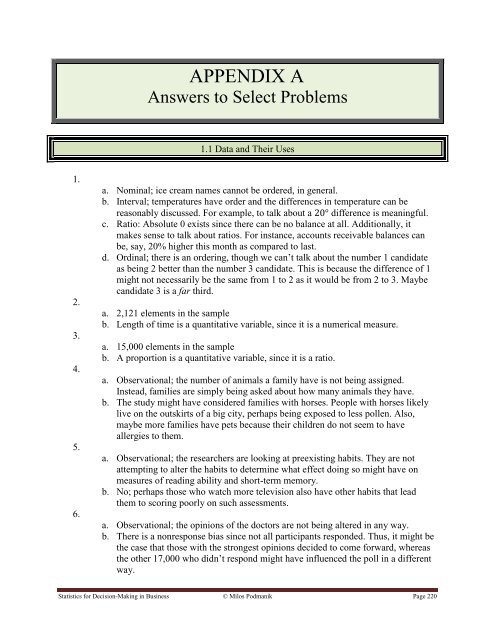Statistics for Decision- Making in Business - Maricopa Community ...
Statistics for Decision- Making in Business - Maricopa Community ...
Statistics for Decision- Making in Business - Maricopa Community ...
Create successful ePaper yourself
Turn your PDF publications into a flip-book with our unique Google optimized e-Paper software.
APPENDIX A<br />
Answers to Select Problems<br />
1.1 Data and Their Uses<br />
1.<br />
2.<br />
3.<br />
4.<br />
5.<br />
6.<br />
a. Nom<strong>in</strong>al; ice cream names cannot be ordered, <strong>in</strong> general.<br />
b. Interval; temperatures have order and the differences <strong>in</strong> temperature can be<br />
reasonably discussed. For example, to talk about a difference is mean<strong>in</strong>gful.<br />
c. Ratio: Absolute 0 exists s<strong>in</strong>ce there can be no balance at all. Additionally, it<br />
makes sense to talk about ratios. For <strong>in</strong>stance, accounts receivable balances can<br />
be, say, 20% higher this month as compared to last.<br />
d. Ord<strong>in</strong>al; there is an order<strong>in</strong>g, though we can‟t talk about the number 1 candidate<br />
as be<strong>in</strong>g 2 better than the number 3 candidate. This is because the difference of 1<br />
might not necessarily be the same from 1 to 2 as it would be from 2 to 3. Maybe<br />
candidate 3 is a far third.<br />
a. 2,121 elements <strong>in</strong> the sample<br />
b. Length of time is a quantitative variable, s<strong>in</strong>ce it is a numerical measure.<br />
a. 15,000 elements <strong>in</strong> the sample<br />
b. A proportion is a quantitative variable, s<strong>in</strong>ce it is a ratio.<br />
a. Observational; the number of animals a family have is not be<strong>in</strong>g assigned.<br />
Instead, families are simply be<strong>in</strong>g asked about how many animals they have.<br />
b. The study might have considered families with horses. People with horses likely<br />
live on the outskirts of a big city, perhaps be<strong>in</strong>g exposed to less pollen. Also,<br />
maybe more families have pets because their children do not seem to have<br />
allergies to them.<br />
a. Observational; the researchers are look<strong>in</strong>g at preexist<strong>in</strong>g habits. They are not<br />
attempt<strong>in</strong>g to alter the habits to determ<strong>in</strong>e what effect do<strong>in</strong>g so might have on<br />
measures of read<strong>in</strong>g ability and short-term memory.<br />
b. No; perhaps those who watch more television also have other habits that lead<br />
them to scor<strong>in</strong>g poorly on such assessments.<br />
a. Observational; the op<strong>in</strong>ions of the doctors are not be<strong>in</strong>g altered <strong>in</strong> any way.<br />
b. There is a nonresponse bias s<strong>in</strong>ce not all participants responded. Thus, it might be<br />
the case that those with the strongest op<strong>in</strong>ions decided to come <strong>for</strong>ward, whereas<br />
the other 17,000 who didn‟t respond might have <strong>in</strong>fluenced the poll <strong>in</strong> a different<br />
way.<br />
<strong>Statistics</strong> <strong>for</strong> <strong>Decision</strong>-<strong>Mak<strong>in</strong>g</strong> <strong>in</strong> Bus<strong>in</strong>ess © Milos Podmanik Page 220
















